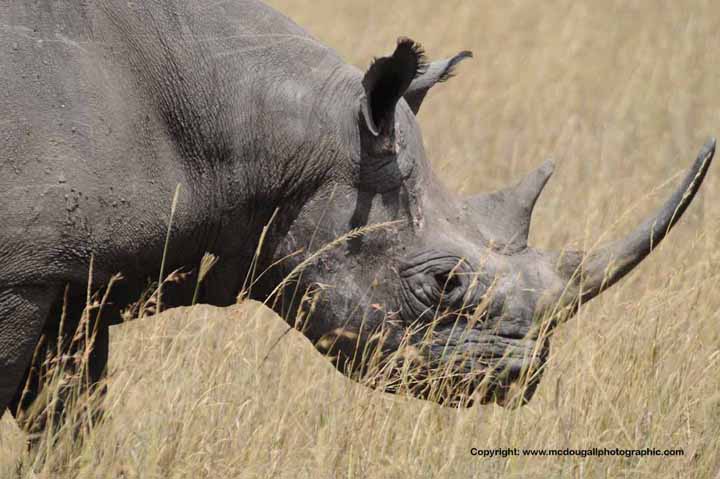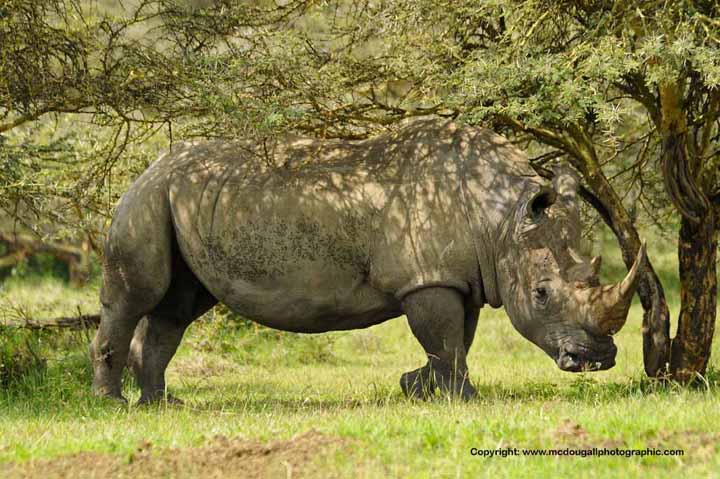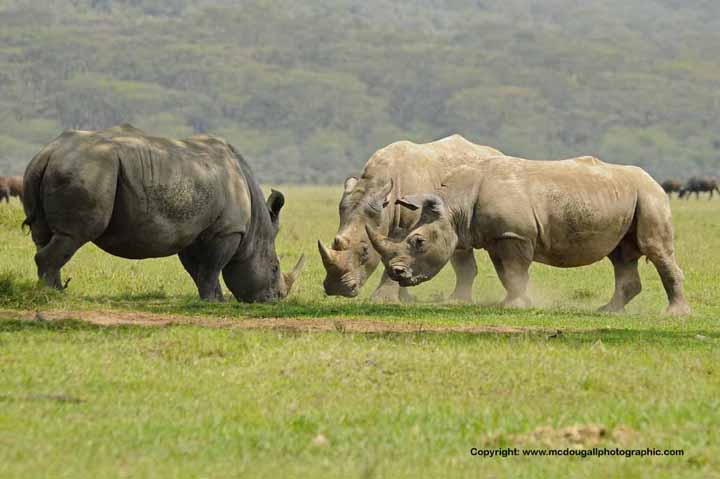Adventure
Black Rhino (Diceros bicornis) and White Rhino (Ceratotherium simum)
-Paul McDougall
There are 2 different species of rhino found in Kenya, the black rhino and the white rhino.
Like other hairless mammals rhinos are wallowers. They also dustbathe, rub and scratch
themselves against objects, regularly visit salt licks, and regularly visit swamps. They
alternately rest and feed day and night, being least active and wallowing most when it is hot.
They are generally solitary animals. Rhino territories are dissected by regularly used trails
and scent posted with dung middens used by both sexes. Territorial bulls also mark by urine
spraying.

African rhinos have longer horns than their Asian relatives. The white rhino is far less
excitable and dangerous to man than the black rhino. Rhinos make a variety of sounds, from
loud puffing snorts of alarm to high-pitched squeals. Both courtship and mating are prolonged.
Gestation lasts 15-16 months and the single offspring remains with the mother 2 – 4 years.
The Black Rhino is a browser and the White Rhino is a grazer, therefore Black Rhino are found in more dense bush and White Rhinos in more open grassland. The Black Rhino is found in Masai Mara, Lake Nakuru and Tsavo.

The White Rhino is found in Lake Nakuru NP where a successful breeding programme has taken place and on smaller private ranches in the Laikipia area.
The Black Rhino was formerly the most widespread and numerous rhino. The range and number dwindled steadily with the increased human population. Its decline was accelerated in the 80’s by poaching to meet demand from Arab and Asian countries, and it is rapidly
approaching extinction. Yet all it needs is protection. The White Rhino was practically exterminated but due to a small breeding population in Natal in South Africa which was heavily protected, these animals have been re-introduced to many areas across Africa.
Over the past few years saving the rhino has been a major Kenyan conservation project and there looks to be a successful and happy ending for these intriguing animals.

I have been lucky enough to see and photograph both black and white rhinos. 2 experiences stick in my mind, both with Black Rhino in Masai Mara. There are only around 24 Black Rhino in the Mara so it is indeed lucky to even see them. The first experience was
a good one, we say a huge male Black Rhino in the open and just watched it for around an hour walking, eating and scent marking – it really was a pleasure to spend so long with these usually elusive animals.
Black Rhinos can be very bad tempered and aggressive, but this is why I remember this moment.
This rhino was so relaxed and comfortable with us.

My other memory of a Black Rhino was a complete contrast. We heard on the radio that a rhino had been seen and went to look for it, we soon saw it, but it was running across the open ground, it looked stressed and so we kept our distance and circled behind
it and watched it from afar. It was trying to get to the thick cover of the bushes across the open ground. Unfortunately at the point we circled behind it 4 safari vehicles sped past us and tried to get closer to it, but all they succeeded in doing was blocking
its route to cover, it then got more agitated and charged one vehicle, just missing it, but then it turned and now we were in its view and it charged straight at us, horn down and full on charge. Now that was a scary moment, and I didn’t manage to get any
photographs. Again Black Rhinos are rarely seen in Mara, and this incident shouldn’t have happened, it was caused by a few inexperienced guides that got it so badly wrong that they put everyone in danger, and succeeded in antagonizing this beautiful animal.

|